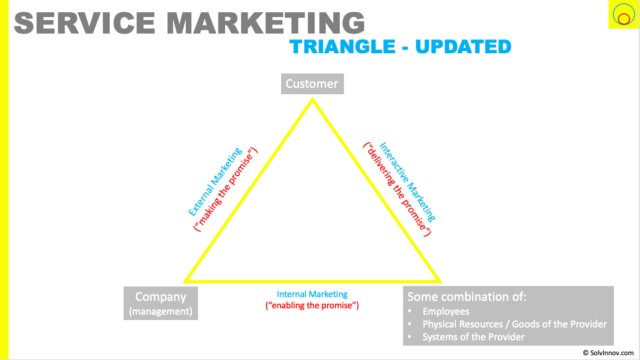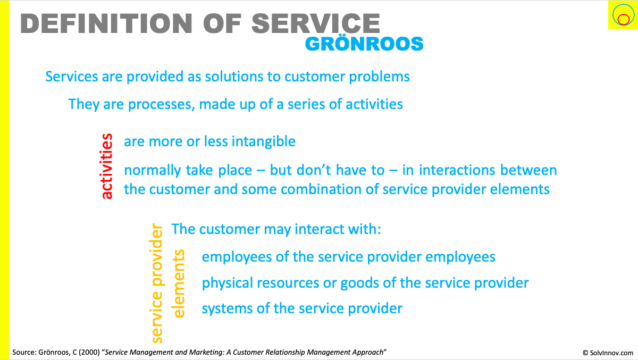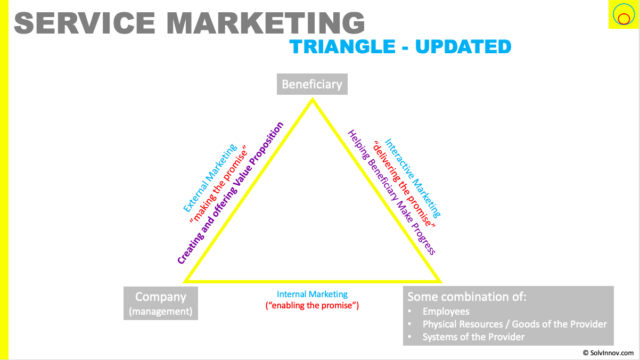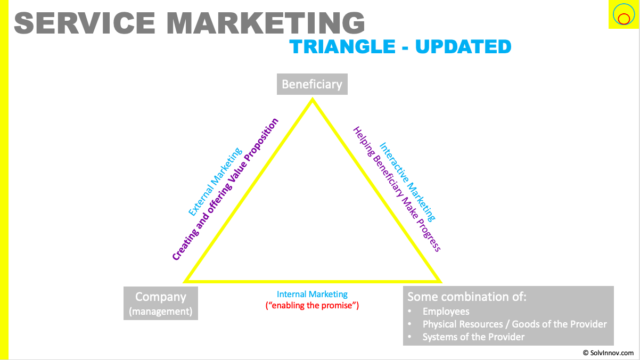The Big Picture…
Service provision – or better put: service progression – can be captured in the services marketing triangle. The original triangle consisted of three actors: company, employees and customer. And three marketing relationships between those actors: external, interactive and internal.
I update this classic view to account for service-dominant logic. Firstly, I expand employees to be the “service provider elements” from Grönroos’ definition of service (that I also call the service mix). That is to say the:
- employees
- systems of the service provider – the electronic employee, so to say
- physical resources/goods of the service provider – the hire car or goods used for self-service


Additionally, I update to bring in some service-dominant logic terminology driven by our improved notion of value. The customer becomes the beneficiary. And the marketing aspects become:
- External marketing – the company is creating and offering a value proposition to the beneficiary
- Interactive marketing – the employees are helping the beneficiary make progress
- Internal marketing – the company is enabling its resources to deliver the promise
Implications
These updates sharpen the view of the service marketing triangle in light of a better definition of value and service.
And we find this triangle reflected in Den Hertog’s description of service – which we can use to start systematically seeking innovations as well as get an insight into innovation complexity for an enterprise.
The Idea
The Services Marketing Triangle is a tool that neatly maps out the three actors involved in providing a service and the necessary marketing relationships between them.
However, it doesn’t quite capture our evolved view of service, service-dominant logic or value. Luckily, only a few tweaks are needed.
What is the Services Marketing Triangle?
Grönroos described the relational nature of marketing in “Relationship Marketing Logic“. His aim was to describe the increasingly important relational aspects of marketing (with the shift to services, compared to the previous product-based world).
Service Provision involves three actors: the customer, the company (management), and the company’s employees. All three actors work together to deliver the service.
And between those three actors, there are marketing relationships to ensure that, as Bitner (1995) puts it, the promise is delivered. These are:
- External marketing: Making the promise – from firm to customers
- Internal marketing: Enabling the promise – from firm to employees
- Interactive marketing: Delivering the promise – from employees to customers
You can see the original Service Marketing Triangle in Figure 1.
But over the years our view of service has evolved. And so we need a few tweaks to this original model to catch up. We should the following:
- Employees
- Customer
- Marketing promises
Let’s jump into seeing why and how I updated employees.
Updating Employees
Not all services are provided by interactions with human employees. In fact, Grönroos later defined service similar to that shown in Figure 2.
And we can see that the customer interacts with more than just employees. They interact with a wider sense of service provider elements. That is to say;
- employees
- service provider systems – for example, artificial intelligence, online banking, booking apps etc, and
- physical resources or goods – for example, the hire car, a beer, etc
I’ve recently starting calling this combination the service mix.
Now we talk about employees (in the wider sense), products/goods, and systems that are enabled by the company and deliver the promise to the customer.
And so, we update the service marketing triangle as shown in Figure 3.

And let’s look at why we would include these groups.
People
We should have a broader definition of employees. First, there are employees in the normal sense. The call centre operative, or the pharmacist, etc. They have a direct connection with the company.
But in this day and age there are increasingly people that deliver the promise who are not direct employees. And here I’m thinking of the gig economy. They need to perform interactive marketing just as well as any direct employee. And so they need to be enabled just as much by company management to deliver the promise. Though that enabling will come from both the hirer and the worker themselves.
Systems
Secondly, we need to consider automated systems, bots and Artificial Intelligence, and so on. These are, you could say, the electronic employees of the organisation. A poorly designed (enabled) bot is not going to deliver on the promise through interactive marketing. They could even be damaging, see “Microsoft chatbot taught to swear on Twitter“.
Physical Resources or goods
And finally, resources used or goods provided are also “employees” that need to be enabled to deliver the promise. This might be a little strange, you think. But resources is easiest to get our heads around. Take the car you might hire. The company has promised luxury and comfort; but if you get a rusting heap that breaks down 10 minutes into your journey, you will not be happy.
Goods are similar to resources – in that they transport service from one place to another, and/or you use them to perform a self-service. These concepts are a foundation to service-dominant logic (see this article if that still seems a little crazy!).
Updating Customer
I will also updated Customer to be Beneficiary. This aligns the marketing triangle with our service-dominant logic view.
If I wanted to be strictly right, I should update Company to be “network of other actors”. But it’s useful in this case to leave it as is to indicate there is a focal point that is driving the marketing promises. And speaking of those, they also need a few tweaks.
Updating Marketing Promises
A I’ve mentioned, between the actors there are various marketing promises. To recap, in the original model they are:
- External: Making the promise (from firm to customers)
- Internal: Enabling the promise (from firm to “service provider elements”)
- Interactive: Delivering the promise (from service provider elements to customers)
We need to update the external and interactive promises to align better with our evolved view of value. That results in the following.
External: Making the promise
Whilst there’s not much wrong with “making the promise”, it’s much better to align with the emerging view of value. And that means talking in terms of value proposition – the proposed value (progress that could be made).
So, instead of “making the promise” I change external marketing to be “creating and offering value proposition”.
Interactive: Delivering the promise
Similarly, I update the interactive marketing of the original service marketing triangle. Instead of “delivering the promise” it is better aligned to value to describe this as “helping beneficiary make progress”
Wrapping Up
We’ve taken the original service marketing triangle and slightly updated to reflect a better view of value and how service happens. It results in the updated service marketing triangle shown below.


It is from this point, we can begin to understand innovation. And start to systematically hunt it. Starting with den Hertog’s model of service and/or altering the service mix.






